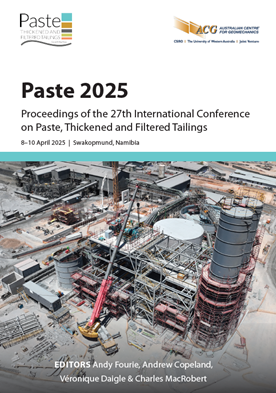Micro paste: producing paste backfill utilising ultra-fine copper tailings

|
Authors: Salvoldi, B; Gerhardi, J |
DOI https://doi.org/10.36487/ACG_repo/2555_15
Cite As:
Salvoldi, B & Gerhardi, J 2025, 'Micro paste: producing paste backfill utilising ultra-fine copper tailings', in AB Fourie, A Copeland, V Daigle & C MacRobert (eds), Paste 2025: Proceedings of the 27th International Conference on Paste, Thickened and Filtered Tailings, Australian Centre for Geomechanics, Perth, pp. 221-232, https://doi.org/10.36487/ACG_repo/2555_15
Abstract:
The new generation of copper mines in central and southern Africa are characterised by finely disseminated ore requiring ultra-fine grinding to liberate the copper. As a result, the tailings produced from these operations are significantly finer than those typically used in backfill applications. In this context, the conventional rules-of-thumb for paste backfill design are no longer applicable, as the cement addition effectively serves as the coarse fraction of the mixture and these mixtures demand significantly higher binder additions to attain comparable unconfined compressive strength (UCS) results. Producing paste backfill from these ultra-fine tailings requires extensive testwork to assess both particle and paste properties. Key factors such as dewatering characteristics, optimal dewatering technology selection, rheology testwork and strength testing are crucial for ensuring that backfill plants can process these tailings and meet the required strength specifications. This paper presents and compares three case studies that explore testwork on ultra-fine copper tailings with a significant micro-sized fraction, providing insights into the challenges and solutions for achieving effective paste backfill in these new mining environments. The findings emphasise the importance of tailored testwork to inform the backfill plant design as well as the underground reticulation design.
Keywords: paste backfill, paste fill, backfill, ultra-fine, copper tailings
References:
Andreasen, AHM 1930, ‘Über die Beziehung zwischen Kornabstufung und Zwischenraum in Produkten aus losen Körnern (About the relation between grain size distribution and voids in products consisting of loose grains)’, Kolloid-Zeitschrift, vol. 50,
ASTM International 2010, Standard Test Method for Preparation and Testing of Controlled Low Strength Material (CLSM) Test Cylinders (ASTM D4832-10), West Conshohocken.
ASTM International 2014, Specific Gravity of Soil Solids by Gas Pycnometer (ASTM D5550-14), ASTM International, West Conshohocken.
Funk, JE & Dinger, DR 1994, ‘Derivation of the dinger-funk particle size distribution equation’, Predictive Process Control of Crowded Particulate Suspensions, 9th edn, Springer Science, Berlin.
Grice, AG, Fallaw, BM & Yumlu, M 2009, ‘Mine backfill system design - current best practice’, International Conference on Advanced Technology in Exploration and Exploitation of Minerals, Mine AdvanTech, Jodhpur, pp. 213–216.
Grieve, G 2009, ‘Chapter 1: cementitious material’, in G Owens (ed.), Fulton's Concrete Technology, 9th edn, Cement & Concrete Institute, Midrand.
Treinen, JM, Cooke, R & Sutherland, D 2010, ‘Paste backfill design case study — Efemçukuru project’, in R Jewell & AB Fourie (eds), Paste 2010: Proceedings of the 13th International Seminar on Paste and Thickened Tailings, Australian Centre for Geomechanics, Perth, pp. 209–216,
Wilson, SC & Leacy, PWJ 2023, ‘Optimal paste backfill specification development’, in GW Wilson, NA Beier, DC Sego, AB Fourie &
D Reid (eds), Paste 2023: Proceedings of the 25th International Conference on Paste, Thickened and Filtered Tailings, University of Alberta, Edmonton, and Australian Centre for Geomechanics, Perth, pp. 294–306,
ACG_repo/2355_22
© Copyright 2025, Australian Centre for Geomechanics (ACG), The University of Western Australia. All rights reserved.
View copyright/legal information
Please direct any queries or error reports to repository-acg@uwa.edu.au
View copyright/legal information
Please direct any queries or error reports to repository-acg@uwa.edu.au
